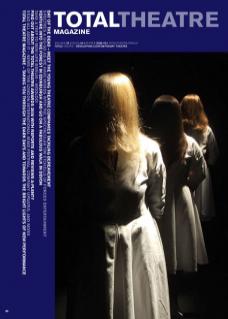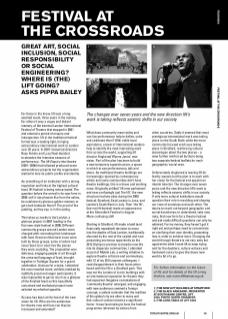For those in the know, lift was a long-awaited event, three years in the making. For others it was a vague and distant memory, of the biennial London International Festival of Theatre that stopped in 2001 and entered a period of enquiry and introspection. lift in the traditional festival format was a leading light, bringing extraordinary international work to London over 25 years. In 2001 renowned directors Rose Fenton and Lucy Neal decided to abandon the intensive seasons of performance. The lift Enquiry into theatre (2001–2006) that followed produced some extraordinary projects but the organisation started to lose its public profile and identity.
As something of an institution with a strong reputation and links at the highest cultural level, lift festival is being reincarnated. The question before the arrival in its new form in 2008: will it rise phoenix like from the ashes, be outshone by glorious golden memory or get stuck between floors? The proof of the pudding, as they say, is in the eating.
This takes us neatly to Eat London, a glorious project in 2007 leading to the first new-style festival in 2008. Different community groups around London were charged with recreating their landscape with food. Great architectural icons were built by these groups, some of whom had never been to or seen live the places they were sculpting. The proposition was delicious, engaging people in art through the universal language of food, brought together in Trafalgar Square for a grand celebration. Anxious for a taste, I attended the overcrowded event, exhibits mobbed by rightfully proud and eager participants. It was impossible to get so much as a glimpse of the finished feast so this beautifully conceived and marketed project never satiated my whetted appetite.
Access has been at the heart of the new vision for lift. Who are the audiences for theatre now and how can they be increased and extended?
What does community mean today and can live performance help to define, unite and celebrate them? With noble local aspirations, a team of international seekers help to identify the most interesting work from across the world, supporting lift director Angharad Wynne Jones’ new vision. Part of the plan has been to build a new temporary superstructure, a space in which to see performances, talk and share. As traditional theatre buildings are increasingly rejected by contemporary artists and some communities don’t have theatre buildings, this is a brave and exciting move. Originally entitled ‘lift new parliament’ and now confusingly just ‘the lift’, the new structure had two sites during the 2008 festival: Stratford, East London in June, and London’s South Bank in July. Then ‘the lift’, (but not lift festival) made an appearance at the Shoreditch Festival in August. More confusing still!
Starting in Stratford, lift made a bold (and financially expedient) decision to move into the depths of East London, traditionally shunned by the rest of the capital and now presenting enormous opportunity as the 2012 Olympics promise to breathe new life into its disparate communities. I attended as part of Mobile Lab, a writing initiative to explore theatre criticism and commentary, with 12 of my 25 European colleagues. I read disappointment in their faces when faced with the lift in a Stratford park. This was not the London of iconic buildings with an international reputation for theatre they had expected. Negative connotations of ‘community theatre’ emerged, and engaging with new audiences seemed a foreign concept, a salient reminder that the realities of this global city are alien to many and that cultural context remains a significant factor. It was fascinating to have the festival programme reframed by visitors from other countries. Sadly it seemed that most prestigious international work was taking place on the South Bank while the more community focused work was taking place in Stratford, reinforcing cultural stereotypes about the two places – a view further reinforced by there being two separate festival leaflets for each geographic/ social area.
Unfortunately Angharad is leaving lift for family reasons but the plan is to work with her vision for the festival and appoint an interim director. The changes over seven years and the new direction lift’s work is taking reflects seismic shifts in our society. If only more cultural institutions would question their role in moulding and shaping our view of ourselves and each other. The desire to reach out beyond geographic and social boundaries; to understand, take new risks, find new form for a theatre festival and ask really difficult questions can only be admired. For my money, they haven’t got it right yet and perhaps need to concentrate on clarifying their own identity, presenting less in order to achieve more. Changing the world through theatre is not very easy but against the odds I want lift to keep trying and for the doubters, culture vultures and hardened cynics to give this brave new world a bit of a go.
For further information on the future of lift, and for details of the lift Living Archive, see www.liftfestival.org.uk

